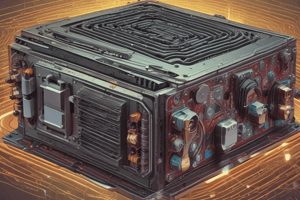Podcast
Questions and Answers
What is the output voltage of the circuit in the first equation?
What is the output voltage of the circuit in the first equation?
- 30 V
- 40 V
- 20 V (correct)
- 10 V
What is the value of I/01 in the given equation?
What is the value of I/01 in the given equation?
- 1.25 A
- 2.25 A
- 2.75 A
- 1.75 A (correct)
What is the design requirement for the output voltage ripple in Example 5.3?
What is the design requirement for the output voltage ripple in Example 5.3?
- 2 percent
- 0.1 percent
- 0.5 percent (correct)
- 1 percent
What is the duty ratio of the buck converter in Example 5.3?
What is the duty ratio of the buck converter in Example 5.3?
What is the switching frequency assumed in Example 5.3?
What is the switching frequency assumed in Example 5.3?
What is the minimum inductor size determined from in Example 5.3?
What is the minimum inductor size determined from in Example 5.3?
What is the value of the inductor chosen in Example 5.3?
What is the value of the inductor chosen in Example 5.3?
What is the input voltage of the buck converter in Example 5.3?
What is the input voltage of the buck converter in Example 5.3?
What is the load resistance of the buck converter in Example 5.3?
What is the load resistance of the buck converter in Example 5.3?
What is the required output voltage of the buck converter in Example 5.3?
What is the required output voltage of the buck converter in Example 5.3?
Flashcards are hidden until you start studying
Study Notes
DC-DC Converter (Chopper)
- A DC-DC converter is a power electronic circuit that converts a DC voltage to a different DC voltage level, often providing a regulated output.
- Applications include switched-mode power supply (SMPS), DC motor control, and battery chargers.
Main Types of Choppers
- Step-down DC-DC converter: output voltage is less than input voltage.
- Step-up DC-DC converter: output voltage is more than input voltage.
- Buck-Boost converter (Step-down/step-up converter): output voltage can be more or less than input voltage.
DC Chopper with Resistive Load
- A DC chopper with a resistive load consists of a DC input voltage source, a controllable switch, and a load resistance.
- The switch is operated with a duty ratio (D) defined as the ratio of the switch ON time to the sum of the ON and OFF times.
- Chopping period (T) = TON (ON time) + TOFF (OFF time).
- Chopping frequency (F) = 1/T.
Buck (Step-Down) Converter
- The input voltage is connected to a controllable semiconductor device that operates as a switch.
- The switch rapidly turns on and off, controlling the flow of current through the circuit.
- A diode is used to allow current to flow when the switch is off, providing a path for the inductor's energy to discharge.
Principle of Operation
- When the switch is turned on, the input voltage is connected to the inductor, causing the current to increase.
- When the switch is turned off, the inductor releases its energy, and the diode becomes forward-biased.
Steady-State Operation
- The net change in current through the inductor in one complete cycle is zero.
- The average inductor current must be the same as the average current in the load resistor.
Output Voltage Ripple
- The variation in output voltage, or ripple, is computed from the voltage-current relationship of the capacitor.
- The ripple factor can be reduced by increasing the switching frequency, inductor size, or capacitor size.
Continuous Current Mode (CCM) Operation
- Imin = 0 is the boundary between continuous and discontinuous current.
- To ensure continuous current, Imin ≥ 0, and L ≥ Lmin.
Studying That Suits You
Use AI to generate personalized quizzes and flashcards to suit your learning preferences.




